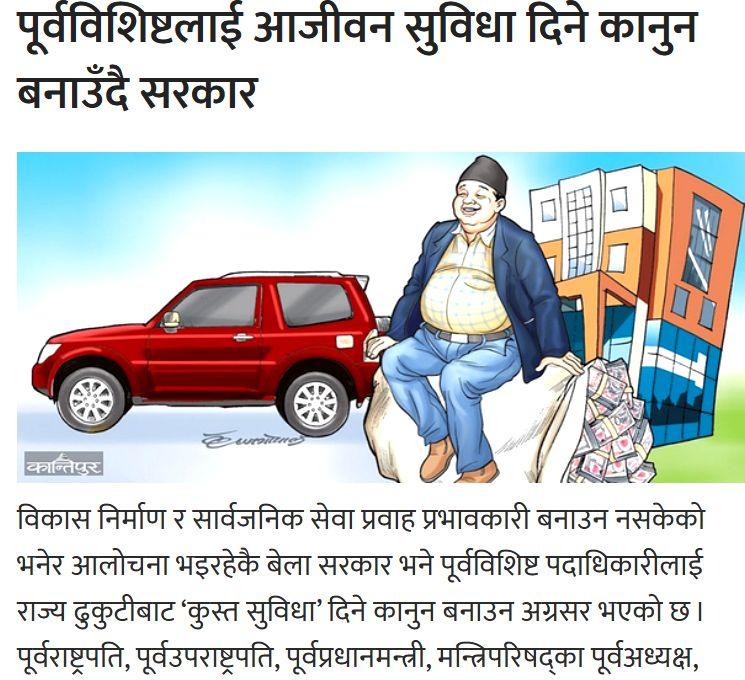Nepal’s New Royalty: The Politicians Who Never Leave the Throne
While the common man struggles to afford basic healthcare, education, and infrastructure, Nepal's politicians are busy crafting laws—not for the welfare of the people, but to ensure their own lifelong comfort. Because, of course, the ultimate goal of public service in Nepal isn't to serve the public—it's to retire into a palace of wealth, luxury cars, and unlimited perks at the expense of taxpayers.
A country drowning in unemployment, failing hospitals, and crumbling roads is somehow "too poor" to invest in its people. But when it comes to these so-called "former dignitaries," suddenly, the state’s treasury overflows like a never-ending fountain of riches. Former presidents, former vice-presidents, former prime ministers, and former ministers—these VIPs are granted a lifetime of privileges, as if Nepal owes them for the “great sacrifices” they made while looting the nation dry.
🔹 A Nation for the People? Or for the Politicians?
What do the people get? Higher taxes, rising inflation, failing public services, and empty promises. But what do these "public servants" get?
Luxury SUVs: While the average Nepali struggles with skyrocketing fuel prices, our ex-ministers glide through traffic in fully-funded, chauffeur-driven luxury vehicles.
Lavish Mansions: Why worry about the housing crisis when the government ensures its former leaders live in palatial homes—paid for by hardworking citizens?
Endless Perks: Security, VIP treatment, and unlimited expenses, all while the country drowns in loans and aid dependency.
🔹 When Will This Looting End?
Nepal is not a monarchy anymore—at least not officially. But in reality, these corrupt politicians have simply replaced the kings, treating government funds like their personal inheritance. The people remain subjects, working tirelessly to fund the extravagant lifestyles of these untouchable elites.
It's time to wake up. It's time to hold these thieves accountable. The country doesn’t owe them a lifetime of luxury—they owe the country an explanation for why, after decades of rule, Nepal is still struggling.
Will the people rise against this blatant abuse of power, or will we continue to watch as they turn Nepal into their personal kingdom?
I makes sense to feed the monarch than to continuously feed the never ending corrupt politicians ! What Say?
Nepal’s New Royalty: The Politicians Who Never Leave the Throne
While the common man struggles to afford basic healthcare, education, and infrastructure, Nepal's politicians are busy crafting laws—not for the welfare of the people, but to ensure their own lifelong comfort. Because, of course, the ultimate goal of public service in Nepal isn't to serve the public—it's to retire into a palace of wealth, luxury cars, and unlimited perks at the expense of taxpayers.
A country drowning in unemployment, failing hospitals, and crumbling roads is somehow "too poor" to invest in its people. But when it comes to these so-called "former dignitaries," suddenly, the state’s treasury overflows like a never-ending fountain of riches. Former presidents, former vice-presidents, former prime ministers, and former ministers—these VIPs are granted a lifetime of privileges, as if Nepal owes them for the “great sacrifices” they made while looting the nation dry.
🔹 A Nation for the People? Or for the Politicians?
What do the people get? Higher taxes, rising inflation, failing public services, and empty promises. But what do these "public servants" get?
Luxury SUVs: While the average Nepali struggles with skyrocketing fuel prices, our ex-ministers glide through traffic in fully-funded, chauffeur-driven luxury vehicles.
Lavish Mansions: Why worry about the housing crisis when the government ensures its former leaders live in palatial homes—paid for by hardworking citizens?
Endless Perks: Security, VIP treatment, and unlimited expenses, all while the country drowns in loans and aid dependency.
🔹 When Will This Looting End?
Nepal is not a monarchy anymore—at least not officially. But in reality, these corrupt politicians have simply replaced the kings, treating government funds like their personal inheritance. The people remain subjects, working tirelessly to fund the extravagant lifestyles of these untouchable elites.
It's time to wake up. It's time to hold these thieves accountable. The country doesn’t owe them a lifetime of luxury—they owe the country an explanation for why, after decades of rule, Nepal is still struggling.
Will the people rise against this blatant abuse of power, or will we continue to watch as they turn Nepal into their personal kingdom?
I makes sense to feed the monarch than to continuously feed the never ending corrupt politicians ! What Say?















